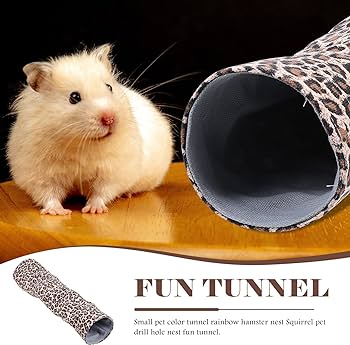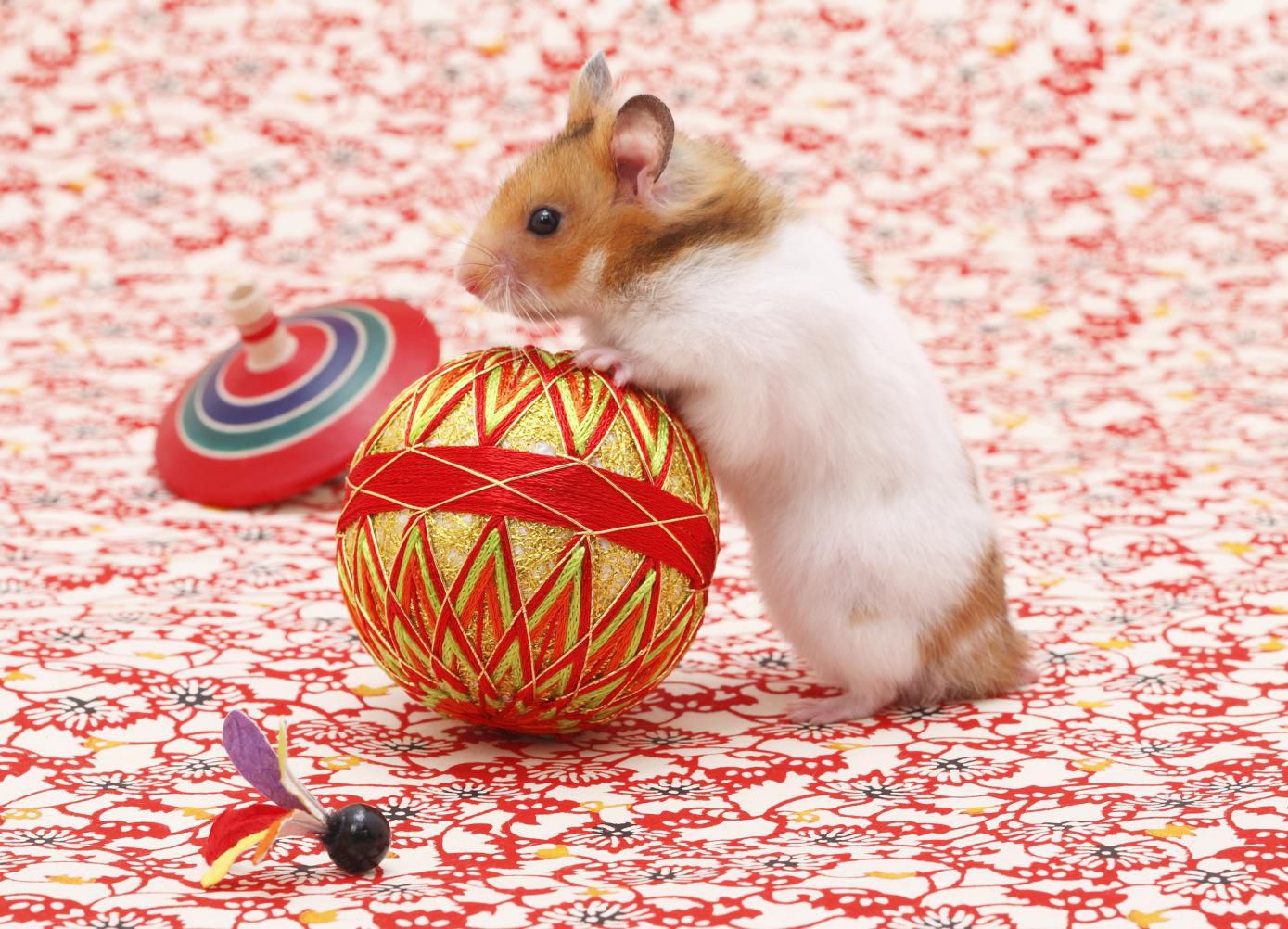Key Takeaways: Enhancing Your Hamster’s Playtime
-
Hamsters need a variety of toys and activities for mental and physical stimulation.
-
Creating DIY obstacle courses and mazes can be a fun and cost-effective way to enrich your hamster’s environment.
-
Tunnels, hoops, and see-saws add excitement and encourage natural behaviors.
-
Building bridges and structures from safe, untreated materials promotes healthy chewing and exploration.
-
It’s crucial to regularly inspect and maintain toys to ensure they remain safe for your furry friend.
The Joyous World of Hamster Enrichment
When it comes to hamsters, their tiny size doesn’t limit the huge amount of joy they can experience through the right enrichment. It’s not just about keeping them busy; it’s about engaging their natural instincts and ensuring their well-being. Enrichment is the spice of life for these little creatures, and as a caring pet owner, it’s up to you to sprinkle that spice generously!

“Hamster Tunnel Cat Hideout Hamster …” from www.amazon.com and used with no modifications.
Understanding Hamster Behavioral Needs
First things first, hamsters are naturally curious and active creatures. They love to burrow, explore, and forage. In the wild, they would travel for miles each night in search of food. Therefore, replicating these behaviors in a captive environment is essential for their happiness. Without it, they can become bored, which may lead to stress, obesity, and even behavioral issues.
Overview of Enrichment Types
There are various ways to provide enrichment for your hamster. These include:
-
Physical Enrichment: Toys and activities that encourage movement and exercise.
-
Mental Enrichment: Challenges that make your hamster think and solve problems.
-
Social Enrichment: Interaction with you or other hamsters (if appropriate).
-
Environmental Enrichment: Changes to their living space that stimulate their senses.
By combining these types, you can create a rich and varied experience for your pet.
Setting Up the Ultimate Hamster Playground
Let’s dive into the heart of hamster playtime: the playground. This is where creativity meets practicality. You want to design an environment that’s not only fun but also safe and stimulating for your little buddy.
Constructing Creative Obstacle Courses
Obstacle courses are a fantastic way to provide physical enrichment. You can use household items like cardboard, untreated wood, and PVC pipes to build a course. Here’s a simple way to get started:
-
Gather safe materials that you can find around the house, like cardboard boxes, tubes, and paper towel rolls.
-
Arrange these items in a sequence that encourages climbing, jumping, and crawling.
-
Change the course regularly to keep your hamster interested and challenged.
Remember, safety is paramount. Make sure all materials are free from sharp edges and haven’t been treated with chemicals. For more ideas, you can learn about how to build hamster toys out of household items.
Designing Brain-Boosting Mazes
Example: For a DIY hamster maze, you can cut out the sides of a cardboard box and place treats at various points to entice your hamster through the puzzle.
Mazes are not only entertaining; they’re also great for mental stimulation. By encouraging your hamster to navigate through a labyrinth, you’re tapping into their instinctual need to forage and explore.
To create a maze, you’ll need a flat base like a piece of cardboard and some walls which can be made from additional cardboard or blocks. Draw a layout before you start building to ensure a clear path with a few dead ends for added challenge. Place treats throughout the maze to motivate your hamster to explore every corner.
Introducing Puzzle Toys for Mental Stimulation
Puzzle toys are another excellent way to keep your hamster’s brain ticking. These can be as simple as a homemade treat ball that releases food as it’s rolled or commercial toys designed to challenge your hamster’s problem-solving skills. Whichever you choose, the goal is to make your hamster work a little for their food, mimicking the effort they would exert in the wild.
Keep an eye on how your hamster interacts with the puzzles and adjust the difficulty accordingly. It’s all about finding that sweet spot where the challenge is enough to keep them engaged but not so hard that they give up.
Building Tunnels of Fun and Adventure
Tunnels are a staple in the hamster enrichment toolkit. They mimic the underground burrows that hamsters would naturally create in the wild. By adding tunnels to your hamster’s environment, you provide them with a sense of security and the opportunity for exploration and exercise.
DIY Tunnels and Tube Networks
Creating a network of tunnels is easier than you might think. Start with cardboard tubes from paper towels or toilet paper rolls. Connect them to form a sprawling network for your hamster to navigate. If you’re feeling crafty, you can cut holes in shoe boxes to create ‘rooms’ for your hamster to discover. Just ensure there are no staples or tape that could harm your pet.
Innovative Uses of PVC Pipes
PVC pipes offer a more durable option for tunnel networks. They’re easy to clean and can be arranged in various configurations. When using PVC pipes, choose large enough diameters for your hamster to pass through comfortably and always sand down any sharp edges.
For example, you can create a ‘hamster highway’ with different levels and entry points using PVC pipes and joints. It’s like a mini-adventure park for your furry friend!
When using any materials, always consider the size of your hamster. Syrian hamsters will need larger tunnels than dwarf hamsters. And remember, variety is the spice of life for these little explorers, so switch up the tunnel layouts every so often to keep things interesting.
Dynamic Activities and Exercises
Exercise is vital for hamsters, not just for their physical health but also for their mental well-being. Incorporating dynamic activities into their daily routine keeps them fit and enriches their lives.
Making Movement Exciting with Hoops and See-Saws
Introduce hoops made from safe, bendable materials for your hamster to jump through or crawl under. A mini see-saw can be made from a flat piece of untreated wood balanced on a small block. These activities encourage natural behaviors like climbing and balancing, which are crucial for your hamster’s development.
Benefits of Regular Physical Activity for Hamsters
Regular exercise helps prevent obesity, keeps the cardiovascular system healthy, and can improve the quality of life for your hamster. It also helps to reduce the risk of boredom-related behaviors such as bar chewing or over-grooming.
Hamster Safe Havens: Bridges and Cardboard Structures
Just like their wild counterparts, domestic hamsters need places to hide and rest. Providing structures like bridges and huts not only adds to their sense of security but also to their overall enjoyment.
Easy-to-Build Hamster Bridges
Hamster bridges can be made from a variety of materials, such as popsicle sticks or small dowels. Simply glue the sticks side-by-side with non-toxic glue to create a bridge, then secure it in your hamster’s cage for an added layer of fun and exploration. For more ideas, check out this guide on building hamster toys out of household items.
Upcycling Cardboard into New Play Areas
Cardboard is a fantastic material for creating new play areas. You can fashion houses, platforms, and even multi-level structures. Just remember to remove any adhesive, as it can be dangerous if ingested by your hamster.

“Choosing Toys for Your Pet Hamster” from www.thesprucepets.com and used with no modifications.
Safety First: Ensuring Harmless Playtime
While we want our hamsters to have fun, we must never compromise their safety. Always inspect toys and structures for potential hazards, and make sure everything is stable and secure before introducing it to your pet.
Choosing Safe Materials for Hamster Toys
When selecting materials for your hamster’s toys, opt for those that are non-toxic and free from chemicals. Avoid materials that splinter easily or that your hamster could ingest in large pieces. Regularly check toys for signs of wear and tear, and replace them when necessary.
Untreated Wood: A Cautionary Tale
Untreated wood can be a great material for hamster toys, but you must ensure it’s safe. Some types of wood, like cedar and pine, contain oils that can be harmful to hamsters. Always research or consult with a professional before introducing new wood types into your hamster’s environment.
Toys Store vs. DIY: What’s Best for Your Hamster?
When it comes to hamster toys, you’re often faced with the choice between store-bought and DIY options. Both have their merits. Store-bought toys are convenient and often come with the assurance of safety standards, while DIY projects can be customized and are a great way to bond with your pet. Let’s weigh the options.
Assessing the Quality of Commercial Hamster Toys
Commercial toys are readily available and come in a wide variety. When selecting these toys, look for those made from safe, durable materials that can withstand your hamster’s gnawing. It’s also important to check for small parts that could become choking hazards. Generally, reputable pet stores stock toys that are designed with a hamster’s needs in mind.
Embracing the Satisfaction of DIY Projects
DIY toys, on the other hand, can be just as safe and fun as their commercial counterparts if you’re careful with your materials and design. They provide a personalized touch and can be made from items you already have at home, making them a cost-effective option. Plus, crafting these toys can be a delightful project that enhances your own experience as a pet owner.
Frequently Asked Questions
What are the signs my hamster is bored and needs enrichment?
Bored hamsters may exhibit signs like over-grooming, bar chewing, and lethargy. If you notice any changes in your hamster’s behavior, such as a lack of interest in their environment or decreased activity levels, it might be time to introduce new enrichment activities.
How can I ensure the puzzle toys are safe for my hamster?
To ensure safety, always use non-toxic materials and avoid small parts that could be ingested. Regularly inspect homemade puzzle toys for signs of wear and replace them if they become a safety risk. For commercial toys, follow the manufacturer’s guidelines and check customer reviews for additional assurance.
What’s the best way to clean hamster tunnels and toys?
Cleaning is crucial to prevent the buildup of harmful bacteria. For plastic toys and tunnels, use warm, soapy water and rinse thoroughly. For wooden items, wipe them with a damp cloth and allow them to air dry completely. Avoid harsh chemicals that can be dangerous to your hamster.
How often should I change or add new enrichment activities?
Regularly changing or adding new enrichment activities prevents boredom and keeps your hamster engaged. Aim to introduce something new or rearrange their habitat every week. This will also help you discover what types of activities your hamster enjoys the most.
Can over-enrichment be stressful for hamsters?
While enrichment is vital, too much change or overly complex environments can indeed stress your hamster. Watch for signs of stress such as aggression or withdrawal. A good rule of thumb is to offer a variety of activities but to allow your hamster to choose what they engage with, ensuring they have a safe space to retreat to if they feel overwhelmed.
Enrichment for hamsters is crucial for their well-being and can include activities like obstacle courses, maze-solving, and puzzle toys. These activities not only keep them physically active but also mentally stimulated. Tunnels, hoops, see-saws, and PVC pipe courses can be used to create a dynamic environment. Additionally, building hamster bridges and cardboard structures can provide them with a sense of exploration and play. It’s also important to ensure that any toys and materials used are safe for hamsters, particularly when it comes to untreated wood, which should not contain any chemicals or varnishes that could be harmful to your pet.


